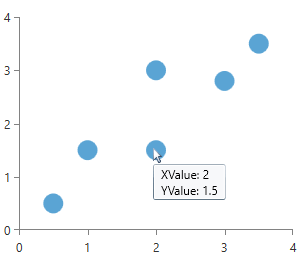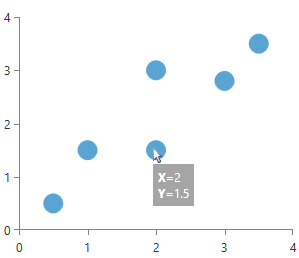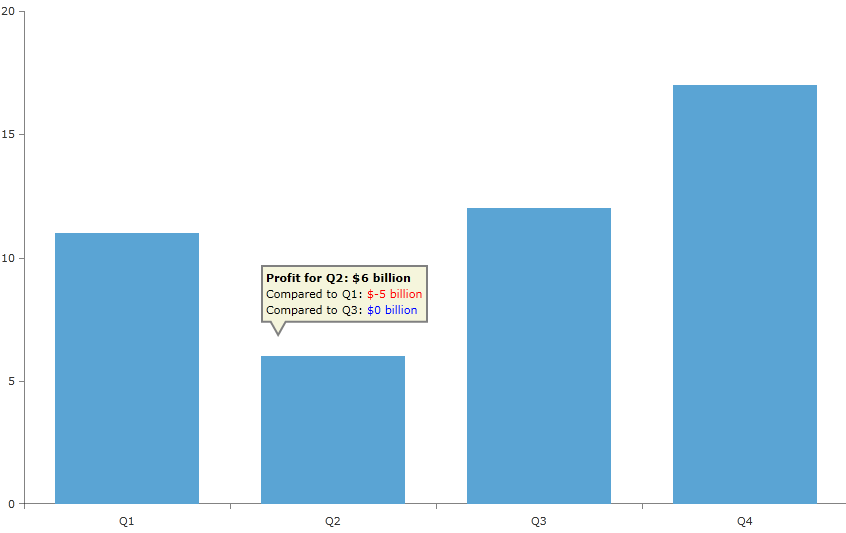Tooltip
RadChartView provides a tooltip behavior which can be used to visualize arbitrary information related to a data point. The tooltip is enabled by adding ChartToolTipBehavior in the Behaviors collection of RadCartesianChart. To display it you can position the mouse cursor over a data point visual.
By default the tooltips of series are shown for their data points only. Each bar represents a datapoint for Bar series, but for Line, Spline and Area series the datapoints are the points that connect the line segments. You should specify the desired shape, color and size for these points to be visualized using DefaultVisualStyle or PointTemplate. Without it practically you won't see a point and respectively there won't be a tooltip for these series.
The user has control over the visualization of the tooltip information and the provided data context. This is done via the TooltipTemplate property which is exposed both by RadCartesianChart and the corresponding series. This allows you to define a custom template on a chart's level for all series and additionally to define different templates for each series. The TooltipTemplate property of the series has a higher priority than the TooltipTemplate of the chart, thus it will override it on a series level.
Defining Tooltip Behavior
The ChartToolTipBehavior should be added in the Behaviors collection of the chart.
Example 1: Defining a tooltip behavior
<telerik:RadCartesianChart>
<telerik:RadCartesianChart.VerticalAxis>
<telerik:LinearAxis/>
</telerik:RadCartesianChart.VerticalAxis>
<telerik:RadCartesianChart.HorizontalAxis>
<telerik:LinearAxis/>
</telerik:RadCartesianChart.HorizontalAxis>
<telerik:RadCartesianChart.Behaviors>
<telerik:ChartTooltipBehavior/>
</telerik:RadCartesianChart.Behaviors>
<telerik:ScatterPointSeries PointSize="20,20">
<telerik:ScatterPointSeries.DataPoints>
<telerik:ScatterDataPoint XValue="0.5" YValue="0.5"/>
<telerik:ScatterDataPoint XValue="1.0" YValue="1.5"/>
<telerik:ScatterDataPoint XValue="2.0" YValue="1.5"/>
<telerik:ScatterDataPoint XValue="2.0" YValue="3.0"/>
<telerik:ScatterDataPoint XValue="3.0" YValue="2.8"/>
<telerik:ScatterDataPoint XValue="3.5" YValue="3.5"/>
</telerik:ScatterPointSeries.DataPoints>
</telerik:ScatterPointSeries>
</telerik:RadCartesianChart>
At this point if you hover a data point visual a tooltip with basic information about the data point is displayed.
Figure 1: Default tooltip example

Customizing the Tooltip
To customize the apperance of the tooltip you can use the TooltipTemplate property. The property can be found both on the RadCartesianChart and the chart series classes.
Example 2: Setting TooltipTemplate of the series
<telerik:ScatterPointSeries.TooltipTemplate>
<DataTemplate>
<Border Background="#5A000000" Padding="5" TextElement.Foreground="White">
<StackPanel>
<StackPanel Orientation="Horizontal">
<TextBlock Text="X=" FontWeight="Bold" />
<TextBlock Text="{Binding XValue}" />
</StackPanel>
<StackPanel Orientation="Horizontal">
<TextBlock Text="Y=" FontWeight="Bold" />
<TextBlock Text="{Binding YValue}" />
</StackPanel>
</StackPanel>
</Border>
</DataTemplate>
</telerik:ScatterPointSeries.TooltipTemplate>
Figure 2: Custom tooltip example

The data context passed to the TooltipTemplate is an object of type DataPoint which can be CategoricalDataPoint, ScatterDataPoint, etc. This means that you may need to use different property paths for the bindings, based on the series type and its DataPoint implementation.
Example
This section demonstrates how to create a custom tooltip that displays the growth or shrinking profits of a fictitious company for each quarter over one year. Even though it will be a bar chart and the bars are more than enough to clearly visualize the relative profits, the example is simple and highlights the usage of RadChartView's tooltip API.
First we will need a chart, which is bound to a collection of custom objects (refer to Create Data-Bound Chart for more details on the binding). The objects in the data source will be used directly as values for the data points as well as content for out tooltips. We create several properties like Quarter, Profit, PreviousQuarter, PreviousDifference, NextQuarter and NextDifference properties for the purpose.
Example 3: Defining the Data Model
public class ProfitDifferenceContext
{
public string Quarter
{
get;
set;
}
public double Profit
{
get;
set;
}
public object PreviousQuarter
{
get;
set;
}
public double PreviousDifference
{
get;
set;
}
public object NextQuarter
{
get;
set;
}
public double NextDifference
{
get;
set;
}
}
Public Class ProfitDifferenceContext
Dim _quarter As String
Dim _profit As Double
Dim _previousQuarter As Object
Dim _previousDifference As Double
Dim _nextQuarter As Object
Dim _nextDifference As Double
Public Property Quarter() As String
Get
Return Me._quarter
End Get
Set(value As String
Me._quarter = value
End Set
End Property
Public Property Profit() As Double
Get
Return Me._profit
End Get
Set(value As Double)
Me._profit = value
End Set
End Property
Public Property PreviousQuarter() As Object
Get
Return Me._previousQuarter
End Get
Set(value As Object)
Me._previousQuarter = value
End Set
End Property
Public Property Profit() As Double
Get
Return Me._previousDifference
End Get
Set(value As Double)
Me._previousDifference = value
End Set
End Property
Public Property NextQuarter() As Object
Get
Return Me._nextQuarter
End Get
Set(value As Object)
Me._nextQuarter = value
End Set
End Property
Public Property NextDifference() As Double
Get
Return Me._nextDifference
End Get
Set(value As Double)
Me._nextDifference = value
End Set
End Property
End Class
We should set data to the values so that it will be able to display information about the currently hovered data point via the TooltipTemplate.
Example 4: Populating and setting the data
public MainPage()
{
InitializeComponent();
List<ProfitDifferenceContext> items = CreateItems();
this.chart.Series[0].ItemsSource = items;
}
private List<ProfitDifferenceContext> CreateItems()
{
List<ProfitDifferenceContext> items = new List<ProfitDifferenceContext>();
Random r = new Random();
const int itemsCount = 4;
for (int i = 0; i < itemsCount; i++)
{
ProfitDifferenceContext profitDiffContext = new ProfitDifferenceContext()
{
Quarter = string.Format("Q{0}", i + 1),
Profit = r.Next(1, 20),
};
items.Add(profitDiffContext);
}
for (int i = 0; i < itemsCount; i++)
{
ProfitDifferenceContext profitDiffContext = items[i];
if (i > 0)
{
ProfitDifferenceContext prevPoint = items[i - 1];
profitDiffContext.PreviousDifference = profitDiffContext.Profit - prevPoint.Profit;
profitDiffContext.PreviousQuarter = prevPoint.Quarter;
}
if (i < itemsCount - 1)
{
ProfitDifferenceContext nextPoint = items[i + 1];
profitDiffContext.NextDifference = nextPoint.Profit - nextPoint.Profit;
profitDiffContext.NextQuarter = nextPoint.Quarter;
}
}
return items;
}
Example 5: Defining the view
<telerik:RadCartesianChart x:Name="chart">
<telerik:RadCartesianChart.HorizontalAxis>
<telerik:CategoricalAxis/>
</telerik:RadCartesianChart.HorizontalAxis>
<telerik:RadCartesianChart.VerticalAxis>
<telerik:LinearAxis/>
</telerik:RadCartesianChart.VerticalAxis>
<telerik:BarSeries CategoryBinding="Quarter" ValueBinding="Profit"/>
</telerik:RadCartesianChart>
Now we need to define our tooltip behavior and set its tool tip template. It will display the value of the selected data point and also how this value relates to the previous and next quarters.
Example 6: Defining the tooltip behavior and the tooltip template
<telerik:RadCartesianChart.Behaviors>
<telerik:ChartTooltipBehavior Placement="Top" VerticalOffset="20" />
</telerik:RadCartesianChart.Behaviors>
<telerik:RadCartesianChart.TooltipTemplate>
<DataTemplate>
<Grid>
<Path Data="M-1236,-441 L-1180,-441 -1180,-424 -1228,-424 -1230.5,-420 -1233,-424 -1236,-424 z"
Stretch="Fill" Fill="Beige" Stroke="Gray" StrokeThickness="2"/>
<StackPanel Margin="5,5,5,18">
<StackPanel Orientation="Horizontal">
<TextBlock Text="Profit for "
FontWeight="Bold" FontSize="11"/>
<TextBlock Text="{Binding Path=DataItem.Quarter}" FontWeight="Bold" FontSize="11"/>
<TextBlock Text=": $" FontWeight="Bold" FontSize="11"/>
<TextBlock Text="{Binding Path=DataItem.Profit}" FontWeight="Bold" FontSize="11"/>
<TextBlock Text=" billion" FontWeight="Bold" FontSize="11"/>
</StackPanel>
<StackPanel Orientation="Horizontal"
Visibility="{Binding Path=DataItem.PreviousQuarter, Converter={StaticResource QuarterToVisibilityConverter}}">
<TextBlock Text="Compared to "/>
<TextBlock Text="{Binding Path=DataItem.PreviousQuarter}"/>
<TextBlock Text=": "/>
<TextBlock Text="$"
Foreground="{Binding Path=DataItem.PreviousDifference, Converter={StaticResource ProfitToBrushConverter}}"/>
<TextBlock Text="{Binding Path=DataItem.PreviousDifference}"
Foreground="{Binding Path=DataItem.PreviousDifference, Converter={StaticResource ProfitToBrushConverter}}"/>
<TextBlock Text=" billion"
Foreground="{Binding Path=DataItem.PreviousDifference, Converter={StaticResource ProfitToBrushConverter}}"/>
</StackPanel>
<StackPanel Orientation="Horizontal"
Visibility="{Binding Path=DataItem.NextQuarter, Converter={StaticResource QuarterToVisibilityConverter}}">
<TextBlock Text="Compared to "/>
<TextBlock Text="{Binding Path=DataItem.NextQuarter}"/>
<TextBlock Text=": "/>
<TextBlock Text="$"
Foreground="{Binding Path=DataItem.NextDifference, Converter={StaticResource ProfitToBrushConverter}}"/>
<TextBlock Text="{Binding Path=DataItem.NextDifference}"
Foreground="{Binding Path=DataItem.NextDifference, Converter={StaticResource ProfitToBrushConverter}}"/>
<TextBlock Text=" billion"
Foreground="{Binding Path=DataItem.NextDifference, Converter={StaticResource ProfitToBrushConverter}}"/>
</StackPanel>
</StackPanel>
</Grid>
</DataTemplate>
</telerik:RadCartesianChart.TooltipTemplate>
The example uses couple of custom binding converters to pretify the visualization. You can find their implementation.
Example 7: Defining converters in the Resources of the chart
<telerik:RadCartesianChart.Resources>
<local:ProfitToBrushConverter x:Key="ProfitToBrushConverter"/>
<local:QuarterToVisibilityConverter x:Key="QuarterToVisibilityConverter"/>
</telerik:RadCartesianChart.Resources>
Example 8: Converters implementation
public class QuarterToVisibilityConverter : IValueConverter
{
public object Convert(object value, Type targetType, object parameter, System.Globalization.CultureInfo culture)
{
if (value == null)
{
return Visibility.Collapsed;
}
return Visibility.Visible;
}
public object ConvertBack(object value, Type targetType, object parameter, System.Globalization.CultureInfo culture)
{
throw new NotImplementedException();
}
}
public class ProfitToBrushConverter : IValueConverter
{
public object Convert(object value, Type targetType, object parameter, System.Globalization.CultureInfo culture)
{
double profitDifference = (double)value;
if (profitDifference < 0)
{
return new SolidColorBrush(Colors.Red);
}
if (profitDifference > 0)
{
return new SolidColorBrush(Colors.Green);
}
return new SolidColorBrush(Colors.Green);
}
public object ConvertBack(object value, Type targetType, object parameter, System.Globalization.CultureInfo culture)
{
throw new NotImplementedException();
}
}
Public Class QuarterToVisibilityConverter
Implements IValueConverter
Public Function Convert(value As Object, targetType As System.Type, parameter As Object, culture As System.Globalization.CultureInfo) As Object Implements System.Windows.Data.IValueConverter.Convert
If value Is Nothing Then
Return Visibility.Collapsed
End If
Return Visibility.Visible
End Function
Public Function ConvertBack(value As Object, targetType As System.Type, parameter As Object, culture As System.Globalization.CultureInfo) As Object Implements System.Windows.Data.IValueConverter.ConvertBack
Throw New NotImplementedException
End Function
End Class
Public Class ProfitToBrushConverter
Implements IValueConverter
Public Function Convert(value As Object, targetType As System.Type, parameter As Object, culture As System.Globalization.CultureInfo) As Object Implements System.Windows.Data.IValueConverter.Convert
Dim profitDifference As Double = DirectCast(value, Double)
If (profitDifference < 0) Then
Return New SolidColorBrush(Colors.Red)
End If
If (profitDifference > 0) Then
Return New SolidColorBrush(Colors.Green)
End If
Return New SolidColorBrush(Colors.Blue)
End Function
Public Function ConvertBack(value As Object, targetType As System.Type, parameter As Object, culture As System.Globalization.CultureInfo) As Object Implements System.Windows.Data.IValueConverter.ConvertBack
Throw New NotImplementedException
End Function
End Class
Figure 3: Example result
